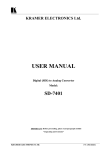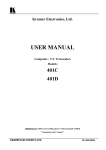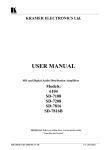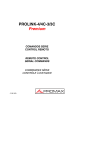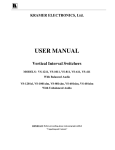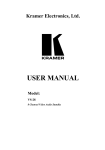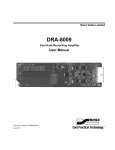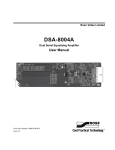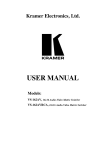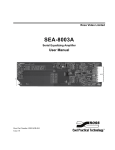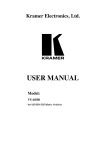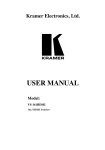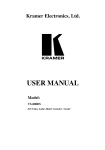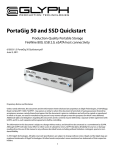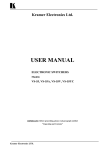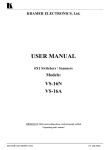Download USER MANUAL - Kramer Electronics
Transcript
KRAMER ELECTRONICS, Ltd. USER MANUAL Kramer SDI Switchers and Matrices Models: SD-7308 SD-7388 SD-7316 IMPORTANT: Before proceeding, please read paragraph entitled "Unpacking and Contents" KRAMER ELECTRONICS LTD. P/N: 2900-006001 Table Of Contents Section Name 1 1.1 1.2 1.3 1.4 1.5 2 3 4 4.1 5 5.1 5.2 5.3 6 6.1 7 7.1 7.2 7.3 7.4 8 8.1 8.2 9 10 10.1 10.2 INTRODUCTION A Word on Video Switchers and Matrices Digital and Analog Video Signals Several Points to Consider When Working with Digital Signals SDI Standards Factors Affecting Quality of Results SPECIFICATIONS HOW DO I GET STARTED? UNPACKING AND CONTENTS Optional Accessories SDI SWITCHER AND MATRICES Getting to Know Your SD-7308 Getting to Know Your SD-7388 Getting to Know Your SD-7316 INSTALLATION Rack Mounting CONNECTING TO DIGITAL VIDEO DEVICES Turning On the Machines Operation RS-232 Communication Protocol for SD-7308 DIP Switch Settings for the SD-7308 OPERATION OF THE SD-7388 AND SD-7316 Menu Commands for the SD-7388 and SD-7316 Communication Protocol for the SD-7388/7316 TAKING CARE OF YOUR MACHINE TROUBLESHOOTING Power and Indicators Video Signal Limited Warranty Page 2 2 2 3 4 4 5 6 6 6 7 7 8 9 10 10 10 10 10 11 11 12 12 14 21 21 21 21 22 List Of Illustrations Figure 1 2 3 4 5 6 Page Digital “EYE” Diagram The Digital “EYE” after accumulating Noise and Jitter SD-7308 Front/Rear Panel Features SD-7388 Front/Rear Panel Features SD-7316 Front/Rear Panel Features RS-232 Null Modem Connection 3 4 7 8 9 20 List Of Tables Table 1 2 3 4 5 6 Page SD-7308 Front/Rear Panel Features SD-7388 Front/Rear Panel Features SD-7316 Front/Rear Panel Features DIPSWITCH Settings for the SD-7308 Instruction Codes for Protocol 2000 Example- HEX table for 16x16 Video Matrix Switch 1 KRAMER ELECTRONICS LTD. 7 8 9 11 15 18 1 INTRODUCTION Congratulations on your purchase of this Kramer Electronics SDI Switcher/Matrix. Since 1981, Kramer has been dedicated to the development and manufacture of high quality video/audio equipment. The Kramer line has become an integral part of many of the best production and presentation facilities around the world. In recent years, Kramer has redesigned and upgraded most of the line, making the best even better. Kramer’s line of professional video/audio electronics is one of the most versatile and complete available, and is a true leader in terms of quality, workmanship, price/performance ratio and innovation. In addition to the Kramer line of high quality switchers, such as the one you have just purchased, Kramer also offers a full line of high quality distributors, processors, interfaces, controllers and computer-related products. This manual includes configuration, operation and option information for the following products from the Kramer line of SDI Switchers and Matrices. All of them are similar in operation and features. SD-7308 – 8x1 SDI Switcher SD-7388 – 8x8 SDI Matrix SD-7316 – 16x16 SDI Matrix 1.1 A Word on Video Switchers and Matrices A video switcher usually switches between several sources (inputs) and one or more acceptors (outputs). A switcher that allows several inputs to be connected to several outputs simultaneously is called a Matrix Switcher. Switchers may be of the electronic or mechanical type. Most matrices are of the active electronic type, with many crosspoints. Vertical interval switching, frequently used in video, ensures that the transition from one video source to another (such as switching between two genlocked cameras) is smooth and without interference. The switching and changeover is done during the blanked vertical interval period, when the transition is hidden from the eyes. Vertical interval switching is needed when recording or transmitting a video program involving several video sources, as in live broadcast, to ensure clean, undisturbed picture transitions. The switched sources should be genlocked. Some matrices have a special, additional input – a genlock input, which is used to genlock the matrix to an external genlock or a studio master reference. Digital (SDI) matrices usually have an analog genlock input, while very few of them offer an additional digital genlock input. Matrices and switchers may sometimes be RS-232 or RS-485/422 controlled. Each of these options is a way of remotely controlling a video/audio device (switcher etc.) using a PC with a serial port, or another device that uses a similar communication protocol. The simplest connection between the RS-232 controller and the controlled device uses two wires (TRANSMIT, RECEIVE) and a common ground wire. 1.2 Digital and Analog video signals An analog signal varies continuously. It may have any value (within its physical bounds) and can change at any instant. A digital signal is made up of a finite number of discrete levels, usually – but not always – changing only at discrete time periods. An example of a digitized waveform is shown below. ANALOG SIGNAL DIGITAL SIGNAL 2 KRAMER ELECTRONICS LTD. 1.3 Several Points to Consider When Working with Digital Signals The minimum noise introduced by quantizing is 1 bit (1 level), so the higher the number of bits, the lower the inherent noise, and the higher the resolution. Since A/D and D/A conversions create artifacts, it is important not to convert back and forth. In a “mixed” outfit, the video should be digitized, and all the digital processing done before converting back to analog. “Multi-media” systems usually quantize the video to 8 bit (ie. 28 = 256) levels. Some “levels” are dedicated to special codes (SAV, EAV – similar to syncs in analog video), leaving 220 quantization levels (~3mV steps) for the luminance signals. Audio is usually quantized to 16 bits. Broadcast systems use 10 bit video, and 20 bit audio. A digital signal may be transported very easily, and saved and retrieved reliably with no generation losses. Transmission of a digital video signal is reliable up to a certain length of cable. Beyond this length, the signal is destroyed. This phenomenon is known as the “cliff-effect”. To avoid the “crash” at the cliff, an “equalizer and reclocker” should be inserted at a distance less than the “cliff” length. From this point it is again possible to drive a cable up to the “cliff” length. This is similar to the “repeater” analogy for analog signals. (Note: the term “equalizer” is usually dropped, and the “equalizer and reclocker” is referred to simply as a “reclocker”). “Equalization” is a process of amplifying the input signal to overcome losses on the cable. This possible for digital signals, since the correct amplitude of the signal is known. “Reclocking” is a process of “cleaning up” the signal in the time-domain, ie, removing the jitter which was introduced as a result of the long cable. To do this, the timing source must be recovered from the signal, and the signal is regenerated with stable timing. A graphic representation of the timing and amplitude distortions is shown in an “eye diagram”, as below: Figure 1: Digital “EYE” Diagram Increase in jitter, and a decrease in amplitude cause the eye to “close”. It is clear that jitter of more than ±50% would result in an irretrievable signal (cliff effect). 3 KRAMER ELECTRONICS LTD. Figure 2: The Digital “EYE” after accumulating Noise and Jitter 1.4 SDI Standards “Uncompressed” digital video usually refers to “Digital Component Video” (ITU-R BT.601 standard). This is based on sampling of component video. The sampling scheme stipulates one luminance (Y) sample for each pair of color-difference (R-Y and B-Y) samples. Luminance sampling is done at 13.5MS/s (mega-samples per second), and each color-difference is sampled at 6.75MS/s. This is also known as 4:2:2 (Y is sampled at 4fsc (more or less!), and the color differences at 2fsc). The 8 or 10 bits of data are serialized to produce a single stream of bits (SMPTE-259 standard) at 270MS/s for 10 bits (10X(13.5+6.75+6.75) = 270). This is known as “Serial Component Video”, and is usually referred to as SDI. “Serial Composite Video” is (true) 4fsc sampling of composite video – PAL at ~177MS/s, and NTSC at ~143MS/s. This standard is hardly used, except in some older installations in the USA. A standard launched about five years ago is “Digital Widescreen” – a digital version of PalPlus (16:9 or Letterbox aspect ratio). This works at 360MS/s. SDI is continuously being upgraded and speeded up. Rates of 540MS/s and beyond 1GS/s are being tested to be used in the near future for full digital HDTV. 1.5 Factors Affecting Quality of Results There are many factors affecting the quality of results when signals are transmitted from a source to an acceptor: Connection cables - Low quality cables are susceptible to interference; they degrade signal quality due to poor matching and cause elevated noise levels. They should therefore be of the best quality. Sockets and connectors of the sources and acceptors - So often ignored, they should be of highest quality, since "Zero Ohm" connection resistance is the objective. Sockets and connectors also must match the required impedance (75ohm in video). Cheap, low quality connectors tend to rust, thus causing breaks in the signal path. Amplifying circuitry - Must have quality performance when the desired result is high linearity, low distortion and low noise operation. Distance between sources and acceptors - Plays a major role in the final result. For long distances (over 15 meters) between sources and acceptors, special measures should be taken in order to avoid cable losses. These include using higher quality cables or adding line amplifiers. Interference from neighboring electrical appliances - These can have an adverse effect on signal quality. Balanced audio lines are less prone to interference, but unbalanced audio should be installed far from any mains power cables, electric motors, transmitters, etc. even when the cables are shielded. 4 KRAMER ELECTRONICS LTD. 2 SPECIFICATIONS SD-7308 SD-7388 SD-7316 Function 8x1 SDI switcher 8x8 SDI Matrix 16x16 SDI Matrix Inputs 8 SMPTE-259M Serial Video, 75 ohms on BNCs 8 SMPTE-259M Serial Video, 75 ohms on BNCs 16 SMPTE-259M Serial Video, 75 ohms on BNCs Outputs 1x4 reclocked SMPTE-259M 8 reclocked SMPTE-259M Serial Video, 75 ohms on Serial Video, 75 ohms on BNCs, with adjustable level BNCs Reference Input NA Analog loop through on BNCs, 75 Ohm/Hi-z, switchable SMPTE-259M serial video (option), any of the 8 serial outputs (option). Analog loop through on BNCs, 75 Ohm/Hi-z, switchable SMPTE-259M serial video (option), any of the 16 serial outputs (option). Switching During Vertical Interval During Vertical Interval During Vertical Interval Resolution 8 or 10-bits, automatic 8 or 10-bits, automatic 8 or 10-bits, automatic Standards 143Mb/s (4fsc NTSC) 143Mb/s (4fsc NTSC) 143Mb/s (4fsc NTSC) 177Mb/s (4fsc PAL) 177Mb/s (4fsc PAL) 177Mb/s (4fsc PAL) 270Mb/s (4:2:2 Component) 270Mb/s (4:2:2 Component) 270Mb/s (4:2:2 Component) 360Mb/s (4:2:2 Widescreen) 360Mb/s (4:2:2 Widescreen) 360Mb/s (4:2:2 Widescreen) Equalization Automatic up to 30 dB of cable loss Automatic up to 300 m, Automatic up to 300 m, (Belden 8281 cable, 270Mb/s) (Belden 8281 cable, 270Mb/s) Jitter NA <300 ps at 270Mb/s, (1kHz HPF) <300 ps at 270Mb/s, (1kHz HPF) Overshoot NA <5% <5% Output Level 800 mV, +/- 5% 800 mV, +/- 5% 800 mV, +/- 5% Control Front panel, RS-232 Front panel, RS-232, RS-485 Front panel, RS-232, RS-485 Display Illuminated front panel switches 2 x 40 backlit LCD 2 x 40 backlit LCD Options NA Serial video genlock card Serial video genlock card Accessories Power cord, Windows 95/98 control software Power cord, Windows 95/98 control software Power cord, Windows 95/98 control software Dimensions 19” 1U, rack mountable 19” 2U, rack mountable 19” 2U, rack mountable Weight 2.5 Kg (5.5 Lbs.) Approx 3.5 Kg (7.8 Lbs.) Approx. 3.5 Kg (7.8 Lbs.) Approx. Power Source 230 VAC (115 VAC, U.S.A) 85-264 VAC, 47-440 Hz, 85-264 VAC, 47-440 Hz, 9.2 VA 20 VA max. 25 VA max. 5 KRAMER ELECTRONICS LTD. 16 reclocked SMPTE-259M Serial Video, 75 ohms on BNCs 3 HOW DO I GET STARTED? The fastest way to get started is to take your time and do everything right the first time. Taking 15 minutes to read the manual may save you a few hours later. You don’t even have to read the whole manual. If a section doesn’t apply to you, you don’t have to spend your time reading it. 4 UNPACKING AND CONTENTS The items contained in your Kramer SDI Switcher/Matrix package are listed below. Please save the original box and packaging materials for possible future shipment. SDI Switcher/Matrix Kramer Concise Product Catalog Power cord This User Manual Null Modem Adapter Rubber Feet Optional Windows 95/98 ™ control software (may be downloaded from Kramer’s website: www.kramerelectronics.com ). 4.1 Optional Accessories The following accessories, which are available from Kramer, can enhance implementation of your distributor. For information regarding cables and additional accessories, contact your Kramer dealer. SD-7108 - an adjustment-free, equalized, reclocking, multi-standard Serial Video Distribution Amplifier. A parallel ECL reclocked output is also provided. The machine provides automatic equalization for losses on 75-ohm co-axial cable (up to hundreds of meters of cable - depending on the cable and the video standard), and reclocks the output to provide 8 low-jitter, serial digital outputs. Standard recognition is automatic, and front-panel LEDs indicate the detected standard. 4fsc PAL, 4fsc NTSC, Component 4:2:2, and high-definition 16:9 (wide-screen) standards are all recognized. The user may adjust the serial video output level. The CARRIER LED indicates the detection of a signal at the input, and the SYNC LED shows that horizontal synchronization has been detected. The machine operates for both 10-bit and 8-bit video, automatically recognizing the word length. SD-7208 - an adjustment-free, reclocking, multi-standard Serializer/SDI Distribution Amplifier. The machine embeds the clock and parallel data into an NRZI serial stream according to the SMPTE 259M standard and reclocks the output to provide 8 low-jitter, serial digital outputs. Standard recognition is automatic. A front panel LED indicates locking to the incoming signal. The user may adjust the serial video output level. The machine operates for both 10-bit and 8-bit video, automatically recognizing the word length. SD-7401 - a multi-standard, adjustment-free digital to analog converter designed to accept one SDI (4:4:2 serial digital video) input, and provide one analog output in four common signal formats. The SDI input is equalized and reclocked, and the output can be set for composite video, S-video (Y/C), RGsB, or Y, R-Y, B-Y. The SD-7401 also has an internal 75% color bar generator, whose timing is based on the SDI input. The SD-7401 encodes 525 line signals to NTSC-M and 625 lines to PAL-B. Versions designed for other standards such as SECAM, PAL-M, and NTSC 4.43 are available by special request. When encoding NTSC, the unit may be programmed with or without a 7.5 IRE setup (pedestal). 6 KRAMER ELECTRONICS LTD. 5 SDI SWITCHER AND MATRICES This section describes all the controls and connections of your switcher/matrix. Understanding all of the controls and connections helps you realize the full power of your machine. 5.1 Getting to Know Your SD-7308 Switcher The Kramer SD-7308 is a multi-standard, adjustment-free 8x1 switcher for SDI (serial digital) video signals. It accepts up to eight SDI inputs, provides necessary buffering and reclocking, and routes the selected source to four identical SDI outputs using BNC connectors. It provides automatic equalization for losses typical with long runs of 75-ohm co-axial cable. Depending on the cable and video standard, cable lengths of several hundred meters is possible. Standard recognition is automatic and the machine switches during the vertical interval according to the SMPTE RP-168 standard. A rear-panel output level control is provided to optimize signal level. The input select function of the SD-7308 can be controlled by front panel buttons and by RS-232 commands transmitted by a touch-screen control system, personal computer, or other control system. When no signal exists on a selected input, the LED in the appropriate button flashes. The SD-7308 automatically recognizes the word length for both 10-bit and 8-bit video. Panel features of the SD-7308 are described in Figure 3 and Table 1. Note: For operation instructions refer to section 7.2. Figure 3: SD-7308 Front/Rear Panel Features Table 1: SD-7308 Front/Rear Panel Features No. 1. 2. 3. 4. 5. 6. 7. 8. Feature POWER INPUT SELECTOR SDI INPUTS OUT LEVEL SDI OUTPUTS PROGRAM RS-232 POWER SOCKET Function Power ON/Off switch, illuminates when toggled. 8 illuminated touch buttons select the desired input 8 BNCs connect up to 8 SDI sources to the switcher Controls the output level of the SDI signals. 4 parallel SDI reclocked outputs Dip switches for programming the switcher RS-232 connection to a PC or to another control device A socket with fuse for connecting the mains power cord 7 KRAMER ELECTRONICS LTD. 5.2 Getting to Know Your SD-7388 Matrix The Kramer SD-7388 is an adjustment-free, 8x8 matrix switcher for SDI (serial digital) video signals. It is a true matrix allowing any input to be routed to any or all outputs simultaneously. It provides automatic equalization for losses on a 75-ohm co-axial cable, and reclocks each output to provide 8 low-jitter serial digital outputs. Video standard recognition is automatic, and switching is during the vertical interval. The SD-7388 accepts either analog or serial video as the external source for its vertical trigger, and any output can be assigned as the sync source. Front panel buttons, RS-232 and RS-485, are the control options. It is fully compatible with both 10-bit and 8-bit video, automatically recognizing word length. Panel features of the SD-7388 are described in Figure 4 and Table 2. Note: For operation instructions refer to section 7.2. Figure 4: SD-7388 Front/Rear Panel Features Table 2: SD-7388 Front/Rear Panel Features NO. Feature Function 1. 2. 3. 4. 5. 6. 7. 8. 9. 10. 11. POWER IN OUT MATRIX / STATUS MENU/ENTER DIGITAL OUTPUTS INPUTS EXT SYNC ANALOG 75 Ω Power ON/Off switch, illuminates when toggled. Inputs selector buttons Outputs selector buttons Display of the matrix status and control Programming buttons Optional Digital Genlock input socket Matrix output connectors Matrix input connectors External sync selection switch (Digital or Analog) Analog Genlock / loop sockets Analog Genlock termination switch (terminated to 75Ω when pressed) 12. 13. 14. 15. RS-485 RS-232 IN RS-232 OUT POWER SOCKET RS-485 connector RS-232 input socket (connected to PC or other controller) RS-232 output socket (for next controlled device) A socket with fuse for connecting the mains power cord 8 KRAMER ELECTRONICS LTD. 5.3 Getting to Know Your SD-7316 Matrix The Kramer SD-7316 is an adjustment-free, 16x16 matrix switcher for SDI (serial digital) video signals. It is a true matrix allowing any input to be routed to any or all outputs simultaneously. It provides automatic equalization for losses on a 75-ohm co-axial cable, and reclocks each output to provide 16 low-jitter serial digital outputs. Video standard recognition is automatic, and the SD-7316 switches during the vertical interval. The SD-7316 accepts either analog or serial video as the external source for its vertical trigger, or any output can be assigned as the sync source. The SD-7316 can be controlled by front panel buttons, RS-232, or RS-485. It is fully compatible with both 10-bit and 8-bit video, automatically recognizing word length. Panel features of the SD-7316 are described in Figure 5 and Table 3. Note: For operation instructions refer to section 7.2. Figure 5: SD-7316 Front/Rear Panel Features Table 3: SD-7316 Front/Rear Panel Features NO. Feature Function 1. 2. 3. 4. 5. 6. 7. 8. 9. 10. 11. POWER IN OUT MATRIX / STATUS MENU/ENTER DIGITAL OUTPUTS INPUTS EXT SYNC ANALOG 75 Ω Power ON/Off switch, illuminates when toggled. Inputs selector buttons Outputs selector buttons Display of the matrix status and control Programming buttons Optional Digital Genlock input socket Matrix output connectors Matrix input connectors External sync selection switch (Digital or Analog) Analog Genlock / loop sockets Analog Genlock termination switch (terminated to 75Ω when pressed) 12. 13. 14. 15. RS-485 RS-232 IN RS-232 OUT POWER SOCKET RS-485 connector RS-232 input socket (connected to PC or other controller) RS-232 output socket (for next controlled device) A socket with fuse for connecting the mains power cord 9 KRAMER ELECTRONICS LTD. 6 INSTALLATION 6.1 Rack Mounting These machines may be rack mounted in a standard 19” (1U) EIA rack, and include rack “ears” at the ends of the front panel. To mount them, simply place the unit's ears against the rack rails of your rack, and insert standard screws through each of the four corner holes. These devices do not require any specific spacing for ventilation above or below the unit. 7 CONNECTING TO DIGITAL VIDEO DEVICES Digital video sources and output devices are connected to an SDI switcher or matrix through the BNC type connectors on the back of the machine. SDI signals are very high frequency carrying signals, and are very sensitive to cable quality and length. They are vulnerable to the “cliff effect” in which the signal will look good after travelling a certain cable length, but when the line is only slightly extended, the signal crashes completely, without any warning. Therefore, keep the length of the cables at the absolute minimum necessary. The machines described in this manual have built in provisions to minimize signal loss and distortions. Both the switcher and the matrices have built-in cable equalization circuitries to compensate for high frequency cable losses, as well as “time-base correction” - reclocking circuitries, which eliminate signal jitter cumulated along the cables. The reclocking circuitry regenerates the signal’s clock pulses, eliminating signal instability and potential “cliff-effects”. With the built in equalization and reclocking circuitries, the switcher and matrices can be operated at cable lengths and distances of hundreds of meters, when high quality cables are used. 7.1 Turning On the Machine 1) 2) 1) 2) 7.2 ❒ ❒ ❒ ❒ ❒ ❒ ❒ ❒ NOTES The machine should only be turned on after all connections are completed and all source devices have been turned on. Do not attempt to connect or disconnect any video signal while it is on. The socket-outlet should be near the equipment and should be easily accessible. To fully disconnect equipment, remove the power supply adapter from the mains socket. Connect the machine's mains socket to the wall socket using the power cord (provided with the machine). Operate the source and the acceptors. OPERATION Connect up to eight (SD-7308, SD-7388) or sixteen (SD-7316) SDI sources to the input sockets. Connect up to four (SD-7308) eight (SD-7388) or sixteen (SD-7316) SDI acceptors to the output sockets. If required, connect the RS-232 port to a PC (or other controller), using a null-modem connection. Connect via the null-modem adapter provided with the machine (plug the adapter into the PC, and connect from the adapter to the machine with a flat-cable). Alternatively, the null-modem connection may be wired as shown at the end of the manual. With the SD-7388 and SD-7316, an RS-232 OUT connector is provided for continuation of the RS-232 line to the next controlled device. Connect the RS-485 connector with simple wires to the next Matrix or controlling device (SD-7388 and SD-7316 only). Connect a Genlock source to either the ANALOG genlock inputs (SD-7388, SD-7316) or to the DIGITAL Genlock input (if you have purchased the DIGITAL genlock option). If you plan to use the Genlock ANALOG source for another machine, connect a cable to the other ANALOG Genlock socket, leading to the next machine - and release the termination switch. If you do not wish to continue the ANALOG Genlock line to another device, press the termination switch IN for proper 75 Ω line termination. If required, install the software provided in the PC which will control the switcher. Operate the sources, the acceptors and the switcher, and, if required, run the PC program. Select the desired source by pressing the appropriate touch switch on the front panel, or by clicking the appropriate mouse button (SD-7308), or source and acceptor buttons (SD-7388, SD-7316). 10 KRAMER ELECTRONICS LTD. 7.3 RS-232 Communication Protocol for SD-7308 RS-232 communication with the SD-7308 is defined using a one byte protocol as defined below. The physical interface with the controller should be via a null-modem connection. MSB 0 7 0 N7 6 N6 5 Machine No. 1 N5 4 N4 3 N3 N2 2 1 New Switch Status LSB N0 0 N7 is only used for communication between the slave and the master and is always 0 for communication with the PC. N6N5N4 is the binary value of the machine we are addressing minus one, e.g., if we wish to address the master (machine 1 by definition), then N6N5N4 = 000, if we wish to address machine 6, then N6N5N4 = 101. N3N2N1N0 is the binary value of the input to be selected, e.g. N3N2N1N0 = 0111 is equivalent to pressing switch 7 on the front of the machine. Several special codes are also valid: N3N2N1N0 = 1101 requests that the machine being addressed sends its present status to the PC, i.e. which input is selected on that machine. N3N2N1N0 = 1100 requests that the machine being addressed sends its "lock status" to the PC, i.e. whether the machine has locked onto the incoming video or not. If locked, the machine replies with the code N3N2N1N0 = 1011, if not locked, N3N2N1N0 = 1010. When data is sent to the switcher in order to change its status, (i.e. to route a new input to the output), the machine replies by returning that same byte of information. The switching protocol is "bi-directional", i.e. if a button was pressed on a front panel, the byte of information sent from the master to the PC is as described above. The data transfer rate is selected via Dipswitch 7: 1200 baud if Dipswitch 7 is in the OFF position (factory default), or 9600 baud if Dipswitch 7 is in the ON position. There is no parity, 8 data bits and 1 stop bit. 7.4 DIPSWITCH settings for the SD-7308 Up to 8 machines may be controlled using a single RS-232 port by setting the first machine as the "master," and the others as "slaves". The machines are then daisy-chained using a 9-pin flat-cable, and connected to the PC via the null-modem adapter. The dipswitches are to be set as follows (table shows setting for 1200 baud. For 9600 baud, set switch 7 to ON): Machine Number 1 (Master) 2 3 4 5 6 7 8 1 OFF ON OFF ON OFF ON OFF ON 2 OFF OFF ON ON OFF OFF ON ON 3 OFF OFF OFF OFF ON ON ON ON 4 OFF OFF OFF OFF OFF OFF OFF OFF Switch Setting 5 OFF OFF OFF OFF OFF OFF OFF OFF 6 ON OFF OFF OFF OFF OFF OFF OFF Table 4: DIPSWITCH settings for the SD-7308 11 KRAMER ELECTRONICS LTD. 7 OFF OFF OFF OFF OFF OFF OFF OFF 8 ON OFF OFF OFF OFF OFF OFF OFF 8 OPERATION OF THE SD-7388 AND SD-7316 Any single connection can be made with only two keystrokes. Click the Out button with the number corresponding to the destination device. That output appears on the LCD and a cursor will starts to blink underneath it. Then click the In button corresponding to the source device. The number of the selected source unit now appears at the output location, the LCD cursor returns to its home position, and the input to output connection is implemented. Simple as that! If you press the Out button and then change your mind, press another Out button - the unit always follows the last command, and the LCD cursor jumps to the new location. All other operations are accessed using the Menu button. In general, each sequential touch of the Menu button accesses the next menu command. Pressing a button, which is not relevant to the current menu function, will abort the menu command. 8.1 Menu commands for the SD-7388 and SD-7316 Clear SINGLE Output YES -> #OUT, NEXT -> menu This command disconnects a single In to Out connection. If, for example, you made a connection between In #5 and Out #6 and want to disconnect it, press button Out #6. In general, if an output is not being used, it is good practice to ensure that no input is routed to it. This helps minimize the crosstalk distortion on the channels being used. It is not necessary to use this function when making a new crosspoint connection. The old connection is automatically cleared in this case. Clear ALL Outputs YES -> enter, NEXT -> menu . To clear all the outputs, press the ENTER button. This command disconnects all the In to Out connections. To proceed to the next menu function, press the MENU button. Assign ALL Outputs YES -> #In, NEXT -> menu This command essentially causes the SD-7388 or -7316 router to function as a distribution amplifier with equalization and reclocking functions. Pressing the required In button connects that Input with all eight (SD7388) or sixteen (SD-7316) Output lines. The next five commands define the Vertical Interval switching conditions: Recall SETUP YES -> enter, NEXT -> menu Store SETUP YES -> enter, NEXT -> menu The built-in EEPROM memory in the SD-7388 and SD-7316 allows the user to store up to 15 router configurations. The memory stores the setups even after the unit is turned off. Each setup has its own "setup number". In the SD-7388, using the Out keys having the same number accesses the first eight setups. All the other setups may be accessed from the PC or from a remote control panel (VS-3000). When choosing to store or recall a setup, pressing ENTER will invoke the message: Enter SETUP number Use OUTkey 1-8 (SD-7388) Use OUTkey 1-16 (SD-7316) Recall SETUP will display all the information stored in the corresponding setup number. The user has the choice to load this new setup, or to continue using the current configuration. Store SETUP will memorize the current configuration in memory. Any previously saved data in the setup with that number will be lost. Immediate switching YES -> enter, NEXT -> menu There are two modes of switching - vertical interval switching (according to SMPTE recommendation RP 1681993), and immediate switching. 12 KRAMER ELECTRONICS LTD. If you press the Enter button and execute Immediate-switching mode, you will see no VIS on bottom line of the status window. Any connections will be executed immediately. Using the optional board for digital SYNC processing allows switching during the SDI video's vertical interval. There are three options for using SDI video as a time reference. The first is to use a reference SDI signal, connected to the EXT. SYNC - Digital connector on the rear panel. The second is to specify one of the router's outputs as the time reference. The third is to derive the reference from the signal, which is connected to the crosspoint, which is to be switched. The current status of the vertical interval switching parameters is displayed in the right-hand window of the LCD. The lower line shows the selected switching mode, and the top line shows the absence or presence of SYNC, and, if present, its format (50 or 60 Hz). When saving the current configuration in setup memory (see below), the VIS mode is saved along with the current router status. Analog SYNC YES -> enter, NEXT -> menu In the standard configuration, video switching is implemented during the vertical interval period of the EXT. SYNC - Analog input on the rear panel. Digital SYNC External YES -> enter, NEXT -> menu Using the optional board for digital SYNC processing allows switching during the SDI video vertical interval. There are three options for using SDI video as a time reference. The first (this option) is to use a reference SDI signal, connected to the EXT. SYNC - Digital connector on the rear panel. Digital SYNC Internal YES -> enter, NEXT -> menu Using the option board, this option allows the user to specify one of the router's outputs as the time reference. Note: The SDI signal for Digital SYNC Internal is taken from an Output of the unit, not from an Input. So, if using an SDI source as a video reference, ensure that it is routed to the selected Out of the unit. After pressing Enter as the response to this command, the system displays the next step: Which OUTPUT use for SYNC Use OUTkey 1-8 (SD-7388) Use OUTkey 1-16 (SD-7316) Selecting an Out button will connect that Output of the router to the Input of the optional board for extracting its SYNC for the vertical interval reference. This connection has no influence on the output signal itself. Digital SYNC Dynamic Using the option board, this option allows the user to derive the reference from the input signal presently routed to the output which is to be switched. This ensures that vertical interval switching is always implemented, if possible. For example, for a machine which has mixed genlocked and non-genlocked inputs, this mode ensures that when two locked sources are to be switched, this will always be implemented during the vertical interval. Auto store current SETUP YES -> enter, NEXT -> menu OR NO -> enter, NEXT -> menu When the matrix is turned on, the unit is reset with the configuration it had before being turned off. To toggle this function, press the ENTER button. The "auto store" mode is always operational after power-up (or initial reset). Identify MACHINE YES -> enter, NEXT -> menu If ENTER is pressed, the unit displays a message such as: SD-7388 SDI Router (SD-7316 SDI Router) Software ver. 1.00 This is important information for technical support. In the window at the right you will see the message: Machine # 1 After a couple of seconds the message changes to: Change machine # ? YES -> Enter 13 KRAMER ELECTRONICS LTD. When working with a PC or a remote controller, with several machines, it is necessary to assign an individual number (address) to each machine. This is done by pressing Enter and following the instructions on the LCD screen. Initial RESET YES -> enter, NEXT -> menu This is sometimes useful for diagnostic purposes. It allows the machine to be reset to its turned off settings without having to turn the machine off and then on again. 8.2 COMMUNICATION PROTOCOL FOR THE SD-7388/SD-7316 (PROTOCOL 2000) This RS-232 / RS-485 communication protocol uses four bytes of information as defined below. For RS-232, a null-modem connection between the machine and controller is used. The default data rate is 9600 baud, with no parity, 8 data bits and 1 stop bit. MSB LSB DESTI- INSTRUCTION NATION 0 D N5 N4 N3 N2 N1 N0 7 6 5 4 3 2 1 0 1st byte INPUT 1 I6 I5 I4 I3 I2 I1 I0 7 6 5 4 3 2 1 0 2nd byte OUTPUT 1 O6 O5 O4 O3 O2 O1 O0 7 6 5 4 3 2 1 0 3rd byte MACHINE NUMBER 1 0 0 M4 M3 M2 M1 M0 7 6 5 4 3 2 1 0 4th byte 14 KRAMER ELECTRONICS LTD. 1st BYTE: Bit 7 – Defined as 0. D – “DESTINATION”: 0 - for sending information to the switchers (from the PC); 1 - for sending to the PC (from the switcher). N5…N0 – “INSTRUCTION” The function that is to be performed by the switcher(s) is defined by the INSTRUCTION (6 bits). Similarly, if a function is performed via the machine’s keyboard, then these bits are set with the INSTRUCTION NO., which was performed. The instruction codes are defined according to the table below (INSTRUCTION NO. is the value to be set for N5…N0). 2nd BYTE: Bit 7 – Defined as 1. I6…I0 – “INPUT”. When switching (ie. instruction codes 1 and 2), the INPUT (7 bits) is set as the input number which is to be switched. Similarly, if switching is done via the machine’s front-panel, then these bits are set with the INPUT NUMBER which was switched. For other operations, these bits are defined according to the table. 3rd BYTE: Bit 7 – Defined as 1. O6…O0 – “OUTPUT”. When switching (ie. instruction codes 1 and 2), the OUTPUT (7 bits) is set as the output number which is to be switched. Similarly, if switching is done via the machine’s front-panel, then these bits are set with the OUTPUT NUMBER which was switched. For other operations, these bits are defined according to the table. 4th BYTE: Bit 7 – Defined as 1. Bit 6, bit 5 – Defined as 0. M4…M0 – MACHINE NUMBER. Used to address machines in a system via their machine numbers. When several machines are controlled from a single serial port, they are usually configured together with each machine having an individual machine number. For a single machine controlled via the serial port, always set M4…M0 = 1, and make sure that the machine itself is configured as MACHINE NUMBER = 1. Table 5: Instruction Codes For Protocol “2000” Note: All values in the table are decimal, unless otherwise stated. INSTRUCTION # DESCRIPTION 0 RESET VIDEO 1 SWITCH VIDEO 2 SWITCH AUDIO 3 STORE VIDEO STATUS 4 5 RECALL VIDEO STATUS REQUEST STATUS OF A VIDEO OUTPUT REQUEST STATUS OF AN AUDIO OUTPUT 6 DEFINITION FOR SPECIFIC INSTRUCTION INPUT OUTPUT 0 0 Set equal to video input which Set equal to video output which is to be switched is to be switched (0 = disconnect) (0 = to all the outputs) Set equal to audio input which Set equal to audio output which is to be switched is to be switched (0 = disconnect) (0 = to all the outputs) Set as SETUP # (0-15) 0 - to store 1- to delete Set as SETUP # (0-15) 0 Set as SETUP # (0-15) Equal to output number whose status is reqd Set as SETUP # (0-15) Equal to output number whose status is reqd 15 KRAMER ELECTRONICS LTD. NOTE 1 2 2 2, 3 2, 3 4, 3 4, 3 7 VIS SOURCE Set as input # (for OUTPUT byte = 6) or as output # (for OUTPUT byte = 7), or set = 0. 8 BREAKAWAY SETTING 0 9 VIDEO / AUDIO TYPE SETTING 0- for video 1- for audio 10 REQUEST VIS SETTING 11 REQUEST BREAKAWAY SETTING 12 REQUEST VIDEO / AUDIO TYPE SETTING 13 16 SET HIGHEST MACHINE NUMBER REQUEST HIGHEST MACHINE NUMBER REQUEST WHETHER SETUP IS DEFINED ERROR / BUSY 17 18 19 RESERVED RESET AUDIO STORE AUDIO STATUS ---0 Set as SETUP #(0-15) 20 21 RECALL AUDIO STATUS SET VIDEO GAIN 22 SET AUDIO GAIN 23 INCREASE / DECREASE VIDEO GAIN Set as SETUP #(0-15) Equal to output number whose gain is to be set (0 = all) Equal to output number whose gain is to be set (0 = all) Equal to output number whose gain is to be increased (0 = all) 24 INCREASE / DECREASE AUDIO GAIN 25 REQUEST GAIN 14 15 Set as SETUP # (0-15), or set to 126 or 127 to request if machine has this function Set as SETUP # (0-15), or set to 126 or 127 to request if machine has this function Set as SETUP # (0-15), or set to 126 or 127 to request if machine has this function 0-for video 1- for audio for video for audio Set as SETUP # (0-15) 2, 5 2 2 3, 4, 6, 7 3, 4, 6 0- for video 1- for audio 3, 4, 6 Set equal to highest machine number 0 2 0 8 0-error 1-invalid instruction 2-out of range 3- machine busy ---0 0-to store 1-to delete 0 Set as gain value (dB) 9 Set as gain value (dB) 2, 11 0-increase gain 1-decrease gain 2 Equal to output number whose gain is to be increased (0 = all) 0-increase gain 1-decrease gain 2 Equal to output number whose gain is requested (set to 126 or 127 to request if machine has this function) 0-video gain 1-audio gain 3, 6 0 16 KRAMER ELECTRONICS LTD. 0- No VIS (immediate) 1- Input # 1 2- External digital sync 3- External analog sync 4- Dynamic sync 5- Inter-machine sync 6- Input # (INPUT byte) 7- Output #(INPUT byte) 0- audio-follow-video 1- audio breakaway 0- CV 3- RGBS 1- YC 4- SDI 2- YUV I0=0 – Unbalanced audio I0=1 – Balanced audio I1=0 – Digital audio I1=1 – Analog audio I4=0, I3=0, I2=0 – Mono I4=0, I3=0, I2=1 – Stereo VIS source Input # or output # of source Vertical sync freq (Hz) 0 4 10 1 2, 3 2, 3 2, 6, 11 57 SET AUTO-SAVE 58 59 60 61 RESERVED RESERVED RESERVED IDENTIFY MACHINE 62 DEFINE MACHINE 0-no save 1-auto-save ---------1-video machine name 2-audio machine name 3-video software version 4-audio software version 7-remote control name 8-remote software version 1-number of inputs 2-number of outputs 0 12, 2 ---------0 10 10 10 13 1-for video 2-for audio 3-for SDI 4-for remote panel 14 NOTES on the above table: NOTE 1 - When the master switcher is reset, (e.g. when it is turned on), the reset code is sent to the PC. If this code is sent to the switchers, it will reset according to the present power-down settings. NOTE 2 - These are bi-directional definitions. That is, if the switcher receives the code, it will perform the instruction; and if the instruction is performed (due to a keystroke operation on the front panel), then these codes are sent. For example, if the HEX code 01 85 88 83 was sent from the PC, then the switcher (machine 3) will switch input 5 to output 8. If the user switched input 1 to output 7 via the front panel keypad, then the switcher will send to the PC: 41 81 87 83 When the PC sends one of the commands in this group to the switcher, then, if the instruction is valid, the switcher replies by sending to the PC the same four bytes that it was sent (except for the first byte, where the DESTINATION bit is set high). NOTE 3 - SETUP # 0 is the present setting. SETUP # 1 to SETUP # 15 are the settings saved in the switcher's memory, (i.e. those used for Store and Recall). NOTE 4 - The reply to a "REQUEST" instruction is as follows: the same instruction and INPUT codes as were sent are returned, and the OUTPUT is assigned the value of the requested parameter. The replies to instructions 10 and 11 are as per the definitions in instructions 7 and 8 respectively. For example, if the present status of machine number 5 is breakaway setting, then the reply to the HEX code 0B 81 80 85 would be 4B 81 81 85 NOTE 5 – For the OUTPUT byte set as 6, the VIS source is the input selected using the OUTPUT byte. Similarly, for the OUTPUT byte set as 7, the VIS source is the output selected using the OUTPUT byte. Note also, that on some machines the sync source is not software selectable, but is selected using switches, jumpers, etc. NOTE 6 – If INPUT is set to 127 for these instructions, then, if the function is defined on this machine, it replies with OUTPUT=1. If the function is not defined, then the machine replies with OUTPUT=0, or with an error (invalid instruction code). If the INPUT is set to 126 for these instructions, then, if possible, the machine will return the current setting of this function, even for the case that the function is not defined. For example, for a video switcher which always switches during the VIS of input #1, (and its VIS setting cannot be programmed otherwise), the reply to the HEX code 4A FE 80 81 (i.e. request VIS setting, with INPUT set as 126dec) would be 4A FE 81 81 (i.e. VIS setting = 3, which is defined as VIS from input #1). 17 KRAMER ELECTRONICS LTD. NOTE 7 – Setting OUTPUT to 0 will return the VIS source setting as defined in instruction #7. Setting to 1 will return the input # or output # of the sync source (for the case where the VIS source is set as 3 or as 6 in instruction #7). Setting to 2 returns the vertical sync frequency (0 for no input sync, 50 for PAL, 60 for NTSC, 255 for error). NOTE 8 - The reply to the "REQUEST WHETHER SETUP IS DEFINED" is as in TYPE 3 above, except that here the OUTPUT is assigned with the value 0 if the setup is not defined; or 1 if it is defined. NOTE 9 - An error code is returned to the PC if an invalid instruction code was sent to the switcher, or if a parameter associated with the instruction is out of range (e.g. trying to save to a setup greater than 15, or trying to switch an input or output greater than the highest one defined). This code is also returned to the PC if an RS-232 instruction is sent while the machine is being programmed via the front panel. Reception of this code by the switcher is not valid. NOTE 10 – This code is reserved for internal use. NOTE 11 – For machines where the video and / or audio gain is programmable, the value of the gain is represented in “twos complement” format to allow for negative values (attenuation). NOTE 12 - Under normal conditions, the machine's present status is saved each time a change is made. The "powerdown" save (auto-save) may be disabled using this code. Note that whenever the machine is turned on, the auto-save function is set. NOTE 13 - This is a request to identify the switcher/s in the system. If the INPUT is set as 1 or 2, the machine will send its name. The reply is the decimal value of the INPUT and OUTPUT. For example, for a 2216, the reply to the request to send the audio machine name would be (HEX codes): 7D 96 90 81 (i.e. 128dec+ 22dec for 2nd byte, and 128dec+ 16dec for 3rd byte). If the request for identification is sent with the INPUT set as 3 or 4, the appropriate machine will send its software version number. Again, the reply would be the decimal value of the INPUT and OUTPUT - the INPUT representing the number in front of the decimal point, and the OUTPUT representing the number after it. For example, for version 3.5, the reply to the request to send the version number would be (HEX codes): 7D 83 85 81 (i.e. 128dec+ 3dec for 2nd byte, 128dec+ 5dec and 3rd byte). NOTE 14 - The number of inputs and outputs refers to the specific machine which is being addressed, not to the system. For example, if six 16X16 matrices are configured to make a 48X32 system (48 inputs, 32 outputs), the reply to the HEX code 3E 82 81 82 (i.e. request the number of outputs) would be 7E 82 90 82 ie. 16 outputs Table 6: Example-HEX Table For 16X16 Video Matrix Switch The following table shows an example of the hexadecimal codes for programming a 16X16 video matrix using the “2000” protocol. The example assumes machine number 1, and node 0: 18 KRAMER ELECTRONICS LTD. IN 1 IN 2 IN 3 IN 4 IN 5 IN 6 IN 7 IN 8 IN 9 IN 10 IN 11 IN 12 IN 13 IN 14 IN 15 IN 16 OUT 1 01 81 81 81 01 82 81 81 01 83 81 81 01 84 81 81 01 85 81 81 01 86 81 81 01 87 81 81 01 88 81 81 01 89 81 81 01 8A 81 81 01 8B 81 81 01 8C 81 81 01 8D 81 81 01 8E 81 81 01 8F 81 81 01 90 81 81 OUT 2 01 81 82 81 01 82 82 81 01 83 82 81 01 84 82 81 01 85 82 81 01 86 82 81 01 87 82 81 01 88 82 81 01 89 82 81 01 8A 82 81 01 8B 82 81 01 8C 82 81 01 8D 82 81 01 8E 82 81 01 8F 82 81 01 90 82 81 OUT 3 01 81 83 81 01 82 83 81 01 83 83 81 01 84 83 81 01 85 83 81 01 86 83 81 01 87 83 81 01 88 83 81 01 89 83 81 01 8A 83 81 01 8B 83 81 01 8C 83 81 01 8D 83 81 01 8E 83 81 01 8F 83 81 01 90 83 81 OUT 4 01 81 84 81 01 82 84 81 01 83 84 81 01 84 84 81 01 85 84 81 01 86 84 81 01 87 84 81 01 88 84 81 01 89 84 81 01 8A 84 81 01 8B 84 81 01 8C 84 81 01 8D 84 81 01 8E 84 81 01 8F 84 81 01 90 84 81 OUT 5 01 81 85 81 01 82 85 81 01 83 85 81 01 84 85 81 01 85 85 81 01 86 85 81 01 87 85 81 01 88 85 81 01 89 85 81 01 8A 85 81 01 8B 85 81 01 8C 85 81 01 8D 85 81 01 8E 85 81 01 8F 85 81 01 90 85 81 OUT 6 01 81 86 81 01 82 86 81 01 83 86 81 01 84 86 81 01 85 86 81 01 86 86 81 01 87 86 81 01 88 86 81 01 89 86 81 01 8A 86 81 01 8B 86 81 01 8C 86 81 01 8D 86 81 01 8E 86 81 01 8F 86 81 01 90 86 81 OUT 7 01 81 87 81 01 82 87 81 01 83 87 81 01 84 87 81 01 85 87 81 01 86 87 81 01 87 87 81 01 88 87 81 01 89 87 81 01 8A 87 81 01 8B 87 81 01 8C 87 81 01 8D 87 81 01 8E 87 81 01 8F 87 81 01 90 87 81 OUT 8 01 81 88 81 01 82 88 81 01 83 88 81 01 84 88 81 01 85 88 81 01 86 88 81 01 87 88 81 01 88 88 81 01 89 88 81 01 8A 88 81 01 8B 88 81 01 8C 88 81 01 8D 88 81 01 8E 88 81 01 8F 88 81 01 90 88 81 19 KRAMER ELECTRONICS LTD. OUT 9 01 81 89 81 01 82 89 81 01 83 89 81 01 84 89 81 01 85 89 81 01 86 89 81 01 87 89 81 01 88 89 81 01 89 89 81 01 8A 89 81 01 8B 89 81 01 8C 89 81 01 8D 89 81 01 8E 89 81 01 8F 89 81 01 90 89 81 OUT 10 01 81 8A 81 01 82 8A 81 01 83 8A 81 01 84 8A 81 01 85 8A 81 01 86 8A 81 01 87 8A 81 01 88 8A 81 01 89 8A 81 01 8A 8A 81 01 8B 8A 81 01 8C 8A 81 01 8D 8A 81 01 8E 8A 81 01 8F 8A 81 01 90 8A 81 OUT 11 01 81 8B 81 01 82 8B 81 01 83 8B 81 01 84 8B 81 01 85 8B 81 01 86 8B 81 01 87 8B 81 01 88 8B 81 01 89 8B 81 01 8A 8B 81 01 8B 8B 81 01 8C 8B 81 01 8D 8B 81 01 8E 8B 81 01 8F 8B 81 01 90 8B 81 OUT 12 01 81 8C 81 01 82 8C 81 01 83 8C 81 01 84 8C 81 01 85 8C 81 01 86 8C 81 01 87 8C 81 01 88 8C 81 01 89 8C 81 01 8A 8C 81 01 8B 8C 81 01 8C 8C 81 01 8D 8C 81 01 8E 8C 81 01 8F 8C 81 01 90 8C 81 OUT 13 01 81 8D 81 01 82 8D 81 01 83 8D 81 01 84 8D 81 01 85 8D 81 01 86 8D 81 01 87 8D 81 01 88 8D 81 01 89 8D 81 01 8A 8D 81 01 8B 8D 81 01 8C 8D 81 01 8D 8D 81 01 8E 8D 81 01 8F 8D 81 01 90 8D 81 OUT 14 01 81 8E 81 01 82 8E 81 01 83 8E 81 01 84 8E 81 01 85 8E 81 01 86 8E 81 01 87 8E 81 01 88 8E 81 01 89 8E 81 01 8A 8E 81 01 8B 8E 81 01 8C 8E 81 01 8D 8E 81 01 8E 8E 81 01 8F 8E 81 01 90 8E 81 OUT 15 01 81 8F 81 01 82 8F 81 01 83 8F 81 01 84 8F 81 01 85 8F 81 01 86 8F 81 01 87 8F 81 01 88 8F 81 01 89 8F 81 01 8A 8F 81 01 8B 8F 81 01 8C 8F 81 01 8D 8F 81 01 8E 8F 81 01 8F 8F 81 01 90 8F 81 OUT 16 01 81 90 81 01 82 90 81 01 83 90 81 01 84 90 81 01 85 90 81 01 86 90 81 01 87 90 81 01 88 90 81 01 89 90 81 01 8A 90 81 01 8B 90 81 01 8C 90 81 01 8D 90 81 01 8E 90 81 01 8F 90 81 01 90 90 81 Figure 4: RS-232 Null Modem Connection 20 KRAMER ELECTRONICS LTD. 9 TAKING CARE OF YOUR MACHINE Do not locate your machine in an environment where it is susceptible to dust or moisture. Both of these may damage the electronics, and cause erratic operation or failure. Do not locate your machine where temperature and humidity may be excessive. Doing so may also damage the electronics, and cause erratic operation or failure of your machine. Do not clean your machine with abrasives or strong cleaners. Doing so may remove or damage the finish, or may allow moisture to build up. Take care not to allow dust or particles to build up inside unused or open connectors. 10 TROUBLESHOOTING 1. 2. NOTES Please note that if the output signal is disturbed or interrupted by very strong external electromagnetic interference, it should return and stabilize when such interference ends. If not, disconnect power from the machine and reconnect again to reset the machine. If the recommended actions still do not result in satisfactory operation, please consult your KRAMER Dealer. 10.1 Power and Indicators Problem No Power Remedy 1. 2. 3. Confirm that the rocker switch is in the “ON” position, and that the switch is illuminated. Confirm that power connections are secured at the machine and at the receptacle. Make sure the mains receptacle is active. If still there is no power, remove power cord from AC outlet and then, using a flat head screwdriver, remove the fuse holder located directly below the power connector on your machine. Confirm that the fuse is good by looking for the wire connected between the ends of the fuse. If the wire is broken, replace the fuse with another, with the same rating. 10.2 Video Signal Problem No video at the output device, regardless of input selected. Remedy 1. 2. 3. Confirm that your source and output devices are powered on and connected properly. The input of your machine should be of an identical signal format or standard at the output of your source. Signals at the output of your machine should be of an identical signal format or standard as at the input of your display or acceptor. Confirm that any other device in the signal path have the proper input and/or output selected. Confirm that the maximum cable length was not exceeded. Disappearance of the SDI signal may be a result of the “cliff effect”. 21 KRAMER ELECTRONICS LTD. Noise bars are "rolling" up or down in the output image Hum bars (ground loop) are caused by a difference in the ground potential of any two or more devices connected to your signal path. WARNING! Do not disconnect the ground from any piece of video equipment in your signal path! or: Low Frequency Hum in the output signal Check the following to remove hum bars: 1. 2. 3. Confirm that all interconnected equipment is connected to the same phase of power, if possible. Remove equipment connected to that phase that may introduce noise, such as motors, generators, etc. Disconnect all interconnect cables and reconnect them one at a time until ground loop reappears. Disconnect the affected cable and replace, or insert an isolation transformer in the signal path. LIMITED WARRANTY Kramer Electronics (hereafter Kramer) warrants this product to be free from defects in material and workmanship under the following terms. HOW LONG IS THE WARRANTY Labor and parts are warranted for three years from the date of the first customer purchase. WHO IS PROTECTED Only the first purchase customer may enforce this warranty. WHAT IS COVERED AND WHAT IS NOT COVERED Except as below, this warranty covers all defects in material or workmanship in this product. The following are not covered by the warranty: 1) 2) 3) Any product which is not distributed by Kramer or which is not purchased from an authorized Kramer dealer. If you are uncertain as to whether a dealer is authorized, please contact Kramer at one of the agents listed in the web site www.kramerelectronics.com. Any product, on which the serial number has been defaced, modified or removed. Damage, deterioration or malfunction resulting from: a) Accident, misuse, abuse, neglect, fire, water, lightning or other acts of nature. b) Unauthorized product modification, or failure to follow instructions supplied with the product. c) Repair or attempted repair by anyone not authorized by Kramer. d) Any shipment of the product (claims must be presented to the carrier). e) Removal or installation of the product. f) Any other cause, which does not relate to a product defect. g) Cartons, equipment enclosures, cables or accessories used in conjunction with the product. WHAT WE WILL PAY FOR AND WHAT WE WILL NOT PAY FOR We will pay labor and material expenses for covered items. We will not pay for the following: 1) 2) Removal or installations charges. Costs of initial technical adjustments (set-up), including adjustment of user controls or programming. These costs are the responsibility of the Kramer dealer from whom the product was purchased. 22 KRAMER ELECTRONICS LTD. 3) Shipping charges. HOW YOU CAN GET WARRANTY SERVICE 1) 2) 3) To obtain service on you product, you must take or ship it prepaid to any authorized Kramer service center. Whenever warranty service is required, the original dated invoice (or a copy) must be presented as proof of warranty coverage, and should be included in any shipment of the product. Please also include in any mailing a contact name, company, address, and a description of the problem(s). For the name of the nearest Kramer authorized service center, consult your authorized dealer. LIMITATION OF IMPLIED WARRANTIES All implied warranties, including warranties of merchantability and fitness for a particular purpose, are limited in duration to the length of this warranty. EXCLUSION OF DAMAGES Kramer’s liability for any defective products is limited to the repair or replacement of the product at our option. Kramer shall not be liable for: 1) 2) Damage to other property caused by defects in this product, damages based upon inconvenience, loss of use of the product, loss of time, commercial loss; or: Any other damages, whether incidental, consequential or otherwise. Some countries may not allow limitations on how long an implied warranty lasts and/or do not allow the exclusion or limitation of incidental or consequential damages, so the above limitations and exclusions may not apply to you. This warranty gives you specific legal rights, and you may also have other rights, which vary from place to place. NOTE: All products returned to Kramer for service must have prior approval. This may be obtained from your dealer. NOTICE This equipment has been tested to determine compliance with the requirements of: EN-50081: EN-50082: CFR-47 "Electromagnetic compatibility (EMC); generic emission standard. Part 1: Residential, commercial and light industry" "Electromagnetic compatibility (EMC) generic immunity standard. Part 1: Residential, commercial and light industry environment". FCC Rules and Regulations: Part 15- “Radio frequency devices: Subpart B- Unintentional radiators CAUTION Servicing of the above mentioned machines is only allowed to a Kramer authorized technician or Engineer. Any user who makes changes or modifications to the unit without the express approval of the manufacturer will void user authority to operate the equipment. Use the DC power supply (provided) to supply power to the machine and controllers. Please use recommended interconnect cables to connect the machine to controllers and other components. 23 KRAMER ELECTRONICS LTD. The list of Kramer distributors appears on our web site: www.kramerelectronics.com From the web site it is also possible to e-mail factory headquarters. We welcome your questions, comments and feedback. KRAMER ELECTRONICS LTD. 3 Am VeOlamo Street, Jerusalem 95463, Israel Tel: (972-2)-654-4000. Fax: (972-2)-653-5369 e-mail: [email protected]


























